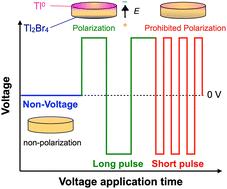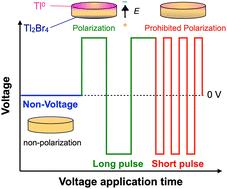TlBr中电压依赖的离子极化:交替方波偏压在离子极化控制中的应用
IF 2.9
3区 化学
Q3 CHEMISTRY, PHYSICAL
引用次数: 0
摘要
为了开发稳定的TlBr基电子器件,研究了TlBr微球在外加电压作用下的极化现象。极化源于Tl+和Br−离子的电泳迁移,并与外加电压有明显的相关性。重要的是,极化可以通过施加交替方波偏压有效地抑制。本文章由计算机程序翻译,如有差异,请以英文原文为准。


Voltage-dependent ionic polarization in TlBr: alternate square-wave bias application for ionic polarization control
Scientific insights into the polarization of TlBr pellets under applied voltage were investigated to develop stable TlBr-based electronic devices. The polarization originates from the electrophoretic migration of Tl+ and Br− ions and shows a clear dependence on the applied voltage. Importantly, the polarization can be effectively suppressed by applying an alternate square-wave bias.
求助全文
通过发布文献求助,成功后即可免费获取论文全文。
去求助
来源期刊

Physical Chemistry Chemical Physics
化学-物理:原子、分子和化学物理
CiteScore
5.50
自引率
9.10%
发文量
2675
审稿时长
2.0 months
期刊介绍:
Physical Chemistry Chemical Physics (PCCP) is an international journal co-owned by 19 physical chemistry and physics societies from around the world. This journal publishes original, cutting-edge research in physical chemistry, chemical physics and biophysical chemistry. To be suitable for publication in PCCP, articles must include significant innovation and/or insight into physical chemistry; this is the most important criterion that reviewers and Editors will judge against when evaluating submissions.
The journal has a broad scope and welcomes contributions spanning experiment, theory, computation and data science. Topical coverage includes spectroscopy, dynamics, kinetics, statistical mechanics, thermodynamics, electrochemistry, catalysis, surface science, quantum mechanics, quantum computing and machine learning. Interdisciplinary research areas such as polymers and soft matter, materials, nanoscience, energy, surfaces/interfaces, and biophysical chemistry are welcomed if they demonstrate significant innovation and/or insight into physical chemistry. Joined experimental/theoretical studies are particularly appreciated when complementary and based on up-to-date approaches.
 求助内容:
求助内容: 应助结果提醒方式:
应助结果提醒方式:


